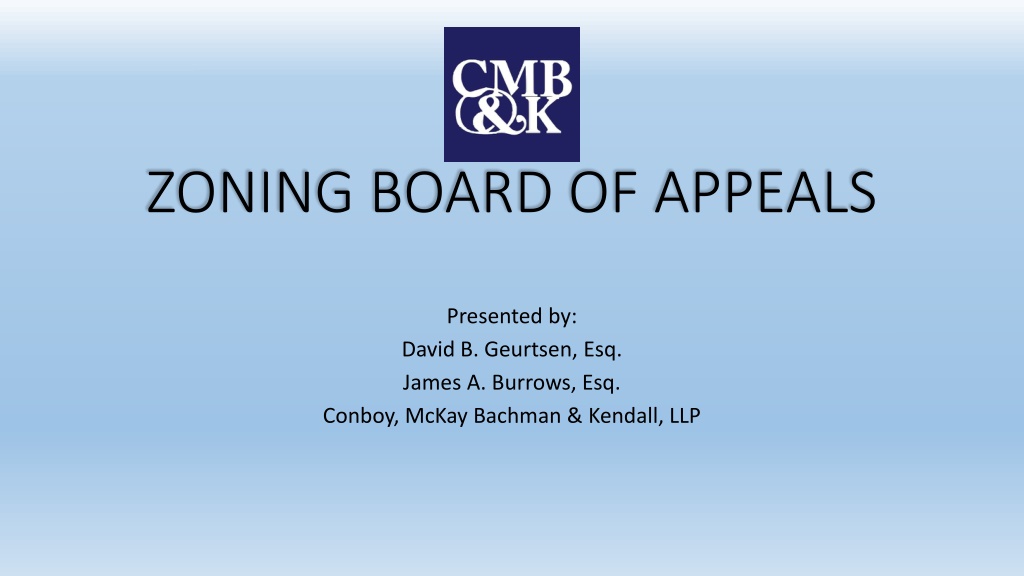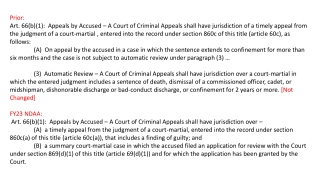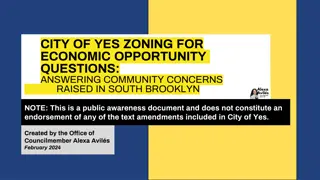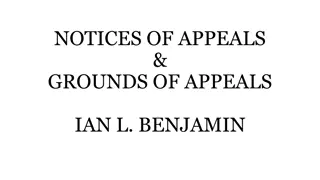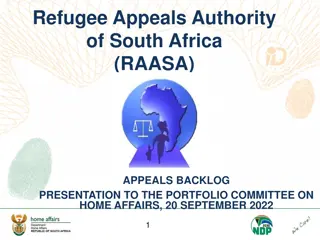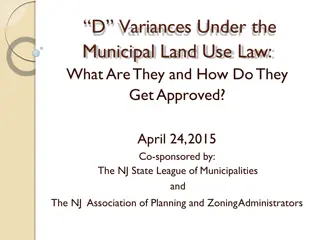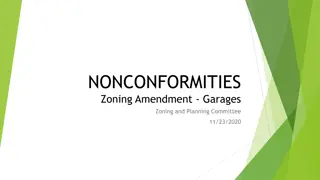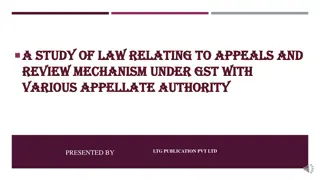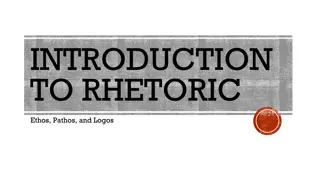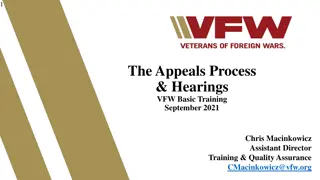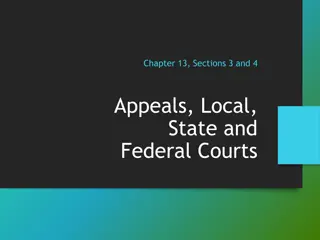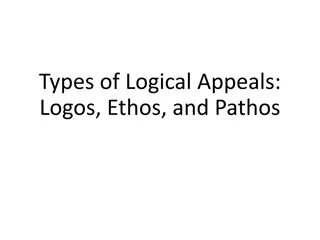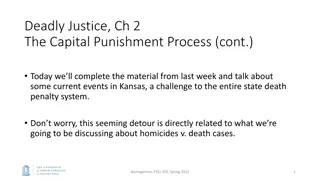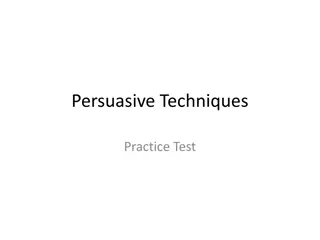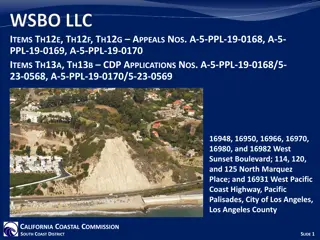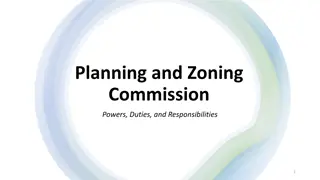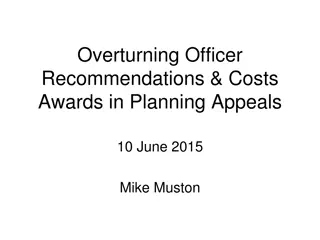Understanding Zoning Board of Appeals in New York
Zoning Board of Appeals (ZBA) plays a crucial role in regulating land use and development in New York. Zoning basics control uses, density, and siting of properties. ZBAs have authority to vary zoning laws and act as a buffer for aggrieved applicants. State laws, local ordinances, and board procedures govern ZBA members. It's essential to understand their functions and rules for effective governance.
Download Presentation

Please find below an Image/Link to download the presentation.
The content on the website is provided AS IS for your information and personal use only. It may not be sold, licensed, or shared on other websites without obtaining consent from the author. Download presentation by click this link. If you encounter any issues during the download, it is possible that the publisher has removed the file from their server.
E N D
Presentation Transcript
ZONING BOARD OF APPEALS Presented by: David B. Geurtsen, Esq. James A. Burrows, Esq. Conboy, McKay Bachman & Kendall, LLP
ZONING BASICS The State of New York grants authority to municipalities to enact local laws to perform governmental functions through its Constitution and statutes. Zoning is a land use tool designed to help implement a municipality's comprehensive plan. Future growth and development of the municipality is controlled by zoning, which furthers the objectives of the comprehensive plan. Zoning has three main components. 1. USE. Zoning regulates the uses allowed in each district. For example, districts might be divided into their simplest form as residential, commercial, light industrial, and heavy industrial with specific uses permitted in one or more districts or some combination of uses. DENSITY. Zoning regulates how intensely uses may be developed by setting minimum and/or maximum lot sizes, and restrictions on the number of residential, office, or other units allowed in buildings within zoning districts. SITING. Zoning regulates where on a parcel primary and accessory structures can be built through setbacks, height limitations and limitations on building in certain areas, such as in floodplains or on steep slopes. 2. 3. 2
THE JOB OF THE THE JOB OF THE ZONING BOARD OF APPEALS ZONING BOARD OF APPEALS Authority to vary the provisions of the zoning law is granted to zoning boards of appeals by Town Law, Village Law, and General City Law. These laws require that a municipality with zoning must have a zoning board of appeals. The board acts as a safetyvalve to keep the zoning restrictions from being overly rigid. The zoning board of appeals exists primarily for its appellate functions, in which it acts as a buffer for aggrieved applicants between decisions of the zoning enforcement officer and the State Supreme Court. ZBAs are granted two appellate functions: 1. 2. Review of applications for use and area variances; and The power to render interpretations of the zoning regulations. The zoning board of appeals can also be given original jurisdiction by the local governing board. Examples of original jurisdiction are the review of special use permits, site plans, and historic preservation certificates. 3
RULES FOR ZBA MEMBERS RULES FOR ZBA MEMBERS A zoning board of appeals (ZBA) is a public body with a variety of rules that apply to how it conducts business. Look at each of the THREE categories of rules. STATE LAW OR REGULATION: State Laws or regulations provide the authority to create a Zoning Board of Appeals, as well as the legal framework under which a ZBA operates. Here are some examples: Public Officers Law sets membership qualifications. Within Public Officers Law is the Open Meetings Law, which relates to meetings of the board, and the Freedom of Information Law, which relates to public documents. Environmental Conservation Law and Regulations - procedures for considering potential impacts of actions on the environment. Zoning Enabling Statutes in Town Law, Village Law and General City Law - authorizes and sets procedures relating to local land use controls. LOCAL LAWS OR ORDINANCES: Local laws and ordinances provide guidance specific to a community. Examples include: ZBA provisions in the zoning law which address the number of members, selection of the chairperson, and eligible training courses. Zoning Law establishing districts, allowed uses, and standards for approvals. Site Plan Review Law specifying uses, how review is triggered, and standards for approvals. Special Use Permit provisions listing uses allowed with additional review, where they are allowed, and criteria for permitting them. PROCEDURES OF THE BOARD: Procedures of the Board, also known as by-laws identify: Duties of officers and committees. Calling meetings, contents of agendas, receipt of public input. Referrals and minutes. Required signature on official documents. Procedures are only binding if adopted by local law or ordinance. 4
ZBA MEMBERSHIP ZBA MEMBERSHIP ELIGIBILTY: Members of a zoning board of appeals are public officers and therefore must be at least 18 years of age, a United States citizen, and a resident of the municipality on whose board they serve. For example, residents of a village may serve on the village ZBA or the ZBA of the town in which the village lies because they are residents of both. However, a resident of a town outside of a village may only serve on the town s zoning board of appeals. Neither members of the municipal governing board nor the zoning enforcement officer may serve on the ZBA. OATH: A member of a zoning board must take and file an oath of office with the municipal clerk at the beginning of each of their terms. If the member fails to file the oath or files it more than 30 days after the beginning of their term, the member is not entitled to a set term of office and could be replaced at any time. Failure to file an oath does not invalidate decisions made while a member was serving without having taken and filed his or her oath of office. REMOVAL: Town boards and village and city mayors have the authority to remove members for cause, such as failure to attend meetings; failure requirements set by the municipality; or because of a State or local ethics violation. A member cannot be removed merely because the mayor or town board is unhappy with his or her voting record on the board. NUMBER: Each ZBA member serves a term of office equal in years to the total number of members on a board. State statute now provides for three or five member zoning boards of appeals. Someone on a zoning board of appeals of five members serves a five-year term. to fulfill training 5
TRAINING REQUIREMENTS TRAINING REQUIREMENTS State law requires that members of zoning boards of appeals receive at least four (4) hours of training each year. Training in excess of four (4) hours in any one year may be carried over into succeeding years. Local governing boards determine what training qualifies for credit. Generally, local governments have decided that land use training presented by the Department of State, the Department of Environmental Conservation, and other State agencies qualifies for the mandatory training. Other qualified training providers may include county planners; municipal organizations (such as the New York Planning Federation, the New York Conference of Mayors, and the New York Association of Towns); and private-sector planners, attorneys, and engineers. Training requirements may be modified or waived by the local governing board if judged to be in the municipality s best interest. To be eligible for reappointment to the zoning board of appeals, members must have completed the training required by their prior term. Decisions made by members who have not satisfied their training requirements are not void for lack of training. 6
OPEN MEETING RULES OPEN MEETING RULES Open Meetings Law provides the public with the legal right to: - Attend meetings of public bodies, listen to debates, watch the decision-making process take place; - Be given notice of the time and place of meetings held by public bodies; and - Ensures that a record of all actions is taken during meetings and are publicly available In short, the law ensures that the public has physical or virtual access to meetings and records of decisions made when a public body has a meeting. It does not give the public the right to participate in the meeting by speaking before the public body. Although, the public body may allow the public to do so. A public body is a group of two or more people that conduct public business and perform a governmental function for the state, an agency of the state, or for public corporations, including committees or subcommittees. This definition covers a wide-range of groups, including state agencies, city councils, town boards or village trustee boards, school boards, planning boards, ZBA s, any related sub-committees, and more. When these and similar groups meet, open meetings law applies. The meetings of groups that are not created by law, like citizen advisory groups, are not required to comply with Open Meetings Law. Also, meetings of political committees and caucuses, judicial and quasi-judicial proceedings, except the Zoning Board of Appeals, and confidential matters protected by state or federal law, are exempt from Open Meetings Law. 7
OPEN MEETING RULES OPEN MEETING RULES (continued) (continued) As defined in Open Meetings Law (102(1)), a meeting is the official convening of a public body for the purpose of conducting public business . When a gathering to discuss public business achieves a quorum, the attendance of a majority of the full membership without vacancies, then the requirements of the open meetings law are triggered. In 1978, the Court of Appeals declared that anytime a group s majority gathers to conduct public business, regardless of whether a decision will be made or what the gathering is called, it is a meeting and is subject to open meetings law. For zoning boards of appeals, who regularly conduct public business, the meetings must be accessible to the public and notice provided. This includes site visits, so be mindful of how many board members attend these and whether there is any discussion on these occasions. 8
OPEN MEETING RULES OPEN MEETING RULES (continued) (continued) Executive Session is a portion of an open meeting that is closed to the public in order to discuss an issue that is among the eight items that are narrowly defined in the law. These eight items include: (1) matters that could threaten public safety is disclosed, (2) identify a law enforcement officer or informer, (3) relate to a potential, current or future litigation, (4) investigation or prosecution of a criminal matter, (5) collective negotiations, (6) various financial, credit, medical or employment details of a person or corporation, (7) proposed sale, lease or purchase of real property or securities, or (8) the details of examination prep, grading or administration. Outside of these topics, all other deliberations of a public body at a meeting are required to be openly addressed before the public and with notice. Plus, to obtain legal guidance from its attorney. The public must be given advance notice of the time and place of a meeting. But the length of time varies based on whether it is a scheduled meeting, impromptu or an emergency. The time and place must be posted in a conspicuous place and notice given to the public and media at least 72 hours prior to a meeting scheduled a week in advance and as soon as practicable for meetings scheduled less than a week in advance. If available, the notice must also be posted online. 9
OPEN MEETING RULES OPEN MEETING RULES (continued) (continued) Open meetings are required to have minutes that serve to record all motions, proposals, resolutions and formal votes on all matters discussed both in a regular and executive session. This includes the votes of each individual voting member. If a matter is discussed, but no action is taken, there is nothing to record and therefore the matter is not required to appear in the minutes. According to law, minutes do not have to be approved, but do have to be prepared and disclosed within two (2) weeks. Any records that are discussed by a public body at an open meeting are required to be made available to the public online to the extent practicable and in response to a request to review, inspect or copy. 10
POTENTIAL APPLICANTS POTENTIAL APPLICANTS There are three types of people who have legal standing to bring an appeal to the zoning board of appeals. 1. The first is an applicant for a land use approval or permit, or a person cited with a zoning violation. He or she may file an appeal of an enforcement officer's determination within 60 days after the ZEO files the decision in his or her office. 2. The second type of person who has standing to appeal is a neighbor or other third party who stands to be harmed by the decision of the zoning enforcement officer. This category of appellants has 60 days from the date they obtain or should have obtained knowledge of the ZEO's decision to file their appeal. 3. The third category is a group of people specifically mentioned in the statutes. They include any officer, department, board or bureau of the municipality. For example, a planning board member, even one who doesn't live anywhere near the subject property, would fall into this category. 11
PUBLIC HEARING PUBLIC HEARING A public hearing is required before the zoning board of appeals may grant a variance or rule on an appeal or decide any other matter. Public hearings, which must be held within a reasonable time after receipt of the appeal, give the public the opportunity to be heard. Every matter that comes before a zoning board of appeals requires a public hearing. Zoning boards of appeals can hold public hearings in conjunction with their regular meetings, but particular applications sometimes require scheduling of a hearing on a separate date if the matter is complicated, is controversial or portends a large audience. Public hearings are sometimes kept open for the public to submit comments in writing, and are sometimes reconvened to afford all those wishing to comment a chance to be heard. Notice of a board of appeals hearing must be printed in a newspaper of general circulation at least five (5) days before the scheduled date of the hearing. Notice should be sent to the parties involved in the appeal at least five (5) days before the hearing, as well as, if applicable, park commissions, and county planning agencies. Details about hearing notices can be found in the zoning enabling statutes. Your local zoning law may also specify local requirements for noticing hearings. 12
COUNTY PLANNING AGENCY REFERRAL COUNTY PLANNING AGENCY REFERRAL General Municipal Law Section 239-m is intended to bring inter- community and county-wide planning and zoning considerations to the attention of neighboring municipalities. It requires local boards to refer certain types of land use actions to the county planning agency if the subject properties of the applications are within 500 feet of certain areas. A written agreement between a municipal board and the county planning agency can list types of applications that do not have to be referred to the county. 13
COUNTY REFERRAL COUNTY REFERRAL There are different kinds of geographic features that may trigger review by the county planning agency under General Municipal Law section 239-m. They include the following features: Municipal Boundary Boundary of State or County Park or Recreation Area R-O-W of State or County Road R-O-W of County-Owned Stream or Drainage Channel Boundary of State or County Land on Which a Public Building is Located Boundary of a Farm Operation that is in a State Agricultural District (not area variances) If in doubt, send it out!! 14
COUNTY REFERRAL TIMING COUNTY REFERRAL TIMING WHEN MAY ZBA ACT? Once the county planning agency has received a complete statement of referral from a zoning board of appeals it will respond to the application in one of four ways. It can: The Zoning Board of Appeals has jurisdiction to take final action when the earlier of the following occurs: it receives the recommendations of the County Planning Agency, OR thirty (30) days have passed since the county s receipt of the full statement. The time period may be extended if agreed to by both the county planning agency and the ZBA. 1) Recommend approval of the application as submitted It is important that the ZBA does not take action prematurely. The board cannot take early votes conditioned on the County Planning Agency's later recommendation for approval. 2) Recommend approval of the application with modifications MAY THE ZBA OVERRIDE COUNTY RECOMMENDATIONS? If the county planning agency recommends disapproval of the application, or approval with modifications, the zoning board of appeals may only act contrary to the county recommendation by a majority-plus-one-vote of all the members of the zoning board of appeals. For example, a county planning agency sends to a zoning board of appeals of five members a report recommending denial of an application. To override the county and approve the application, the majority of that board (three), plus one, for a total of four, would have to vote to approve it. 3) Recommend application; or disapproval of the 4) Report that the application will have no significant county-wide community impact. or inter- Within 30 days after taking final action, the zoning board of appeals must file a report of the final action with the county planning agency and, if applicable, state its reasons for acting contrary to the county's recommendation. The time period may be longer if agreed to by the county and local board. 15
STATE ENVIRONMENTAL QUALITY REVIEW ACT STATE ENVIRONMENTAL QUALITY REVIEW ACT (SEQR) (SEQR) Agencies with land use review authority, including zoning boards of appeals, must consider the New York State Environmental Quality Review Act when reviewing some appeals and applications. The State Environmental Quality Review (SEQR) process encourages review agencies to consider the environmental implications of proposed projects before making decisions. Interpretations and all area variances involving one-, two-, and three-family residences are TypeII actions under SEQR. Also, area variance applications seeking relief from the setback and lot-line requirements of the zoning regulations are Type II actions. Type II actions are presumed as having no adverse environmental impact and therefore not subject to review. Zoning boards of appeals should note in the record that they are Type II actions for SEQR purposes. If a variance request is not on the Type II list, the SEQR process must continue. The lead agency must either issue: (1) a negative declaration, which finds that the project will not result in a significant adverse environmental impact; or affects on the environment. If an agency issues a positive declaration, an environmental impact statement must be prepared prior to the zoning board's ruling on the application. (2) a positive declaration, which finds it may have one or more significant adverse 16
APPELLATE JURISDICTION APPELLATE JURISDICTION The appellate jurisdiction of a ZBA includes two types of appeals: interpretations and variances. Owners or renters of property who request interpretations from the ZBA are claiming that the decision of the zoning enforcement officer was incorrect and are asking the board to reverse the decision of the enforcement officer. Owners of property who request variances acknowledge they are attempting to use or site structures on their property in a manner not allowed by zoning and are asking the ZBA to apply certain standards to determine whether granting relief from the zoning restrictions is warranted. In both types of appeals, zoning boards of appeals must have an actual case for the board to consider, rather than a hypothetical" question. APPEALING ZEO ACTION: The main route to the zoning board of appeals is through the zoning enforcement officer. The appeal is usually of an action or decision of the ZEO. It could be for a permit granted, permit denied, a decision on how to apply the zoning regulations, or the issuance of a citation or some other enforcement action. DIRECT APPEAL: An exception to the rule that there must be an appeal from a ZEO decision is the direct appeal. The State Statutes authorize the ZBA to hear a direct appeal when an applicant for a site plan, special use permit, or subdivision review needs an area variance in connection with their application. That applicant may apply to the ZBA for an area variance without having to first obtain a decision from the ZEO. 17
INTERPRETATIONS OF LAND USE LAWS INTERPRETATIONS OF LAND USE LAWS WHEN THE ZEO S DECISION IS QUESTIONED: An applicant may apply to the zoning board of appeals for an interpretation when he or she believes the ZEO has wrongly interpreted the local zoning regulations. Applicants for interpretations most often believe their proposals are permitted by zoning, although the zoning enforcement officer has ruled otherwise. Neighboring property owners may also appeal for interpretations when they disagree with the ZEO s determination that a proposal does comply with zoning and qualifies for a zoning permit. COMMON TYPES OF INTERPRETATIONS: Often interpretations are sought about what the correct method is of measuring required distances. For example, the local zoning regulations in a Village might require that adult uses be located at least 500 feet from places of worship. The zoning enforcement officer interprets the law to mean measurements are to be taken from the property line of the place of worship to the closest property line of the lot on which building proposed for the adult use is located. The applicant for the adult use appeals the ZEO decision because she believes that the regulations mean that the distance measurement should be taken from front door to front door. Common types of interpretations also involve the definition of a term and whether it describes a use allowed in a particular zoning district. 18
INTERPRETATIONS OF LAND USE LAWS INTERPRETATIONS OF LAND USE LAWS (continued) (continued) BASIS FOR INTERPRETATION: The ZBA bases its interpretation on four general types of information. The first is past decisions the ZBA has made on a similar matter. The current interpretation should be similar, unless new information or new policies have been established that would lead to a different conclusion, such as those based on a new comprehensive plan or based on changes to the zoning regulations. The second type of information is records of a governing board's discussions when adopting the zoning regulations. Minutes and recorded comments from meetings or hearings at which the zoning regulations were discussed by the governing board might reveal to the ZBA what was intended when the provision up for interpretation was adopted. For example, in interpreting the definition of restaurant versus nightclub, minutes of past city council meetings could have included concerns about the proliferation of nightclubs downtown. Minutes of meetings at which the comprehensive plan was considered may have captured a discussion that a separate commercial district should be created to keep establishments whose primary business is serving alcohol and providing live music and entertainment off of Main Street. The third type of information is the ordinary meaning of the term. With no other guidance or evidence, the board of appeals might check common definitions of terms (i.e., restaurant; nightclub) in dictionaries or glossaries of planning terms. Finally, with no other guidance, a board may accept testimony and use discussions of the zoning board to arrive at a common-sense interpretation. 19
REQUEST FOR AN AREA VARIANCE REQUEST FOR AN AREA VARIANCE The other type of appellate jurisdiction is the granting of variances. A variance can be granted only by the zoning board of appeals in response to successful arguments by an applicant that the zoning regulations should not be strictly applied to a particular property. Variances are granted to the property not the property owner, thus they are said to run with the land. There are two types of variances. We ll begin with area variances, which are requested by applicants wishing to use their property in a manner that does not comply with the dimensional or physical requirements of the zoning regulations. Zoning restrictions from which area variances are often requested include: setback requirements; height restrictions; lot coverage maximums; and frontage requirements. 20
AREA VARIANCE CONSIDERATIONS AREA VARIANCE CONSIDERATIONS The statutes contain five items which must be considered by the ZBA when deciding whether to grant an area variance. These five (5) considerations are used to balance the benefit to the applicant of receiving the variance against the burden to the health, safety, and welfare of the community if the variance is granted. Area variance standards are applied to the physical characteristics of the property, not the use. Applicants do not have to pass the five (5) factors of the area variance balancing test, but each factor should be carefully considered by the zoning board of appeals. The five factors include: 1) effect on neighborhood character 2) whether there is an alternative solution that wouldn t require a variance 3) how substantial the request is 4) what the effect granting the variance may have on the environment. 5) whether the difficulty necessitating the area variance is self-created Even though the area variance test is not as stringent as the use variance test, it should not be treated lightly. Upholding the integrity of the zoning regulations is in the hands of the members of the zoning board of appeals. If area variances are granted too frequently, the effects could undermine the intent and protections afforded by zoning. It may also be a sign that the governing board needs to update their zoning regulations. 21
AREA VARIANCE CONSIDERATION #1 AREA VARIANCE CONSIDERATION #1 In the area variance test, the impact the requested variance could have on the character of the surrounding neighborhood is the first consideration the zoning board of appeals must undertake. For example, will granting an area variance to construct a taller building block sunlight from a neighbor s yard or a view of an important building or natural feature? Or will granting an area variance for a reduction in required off-street parking result in many more cars on the street and a shortage of on-street parking for neighboring businesses? Will the forgiving of a few feet of setback even be noticeable, or will it disrupt the building line of a residential neighborhood or result in the uncomfortable shortening of distances to structures on a neighbor s property? 22
AREA VARIANCE CONSIDERATION #2 AREA VARIANCE CONSIDERATION #2 The second consideration is whether there are alternatives the applicant could use that would not require an area variance. The burden to the neighborhood might be greater than the benefit to the applicant if lawful alternatives exist that would result in an acceptable outcome without the need for an area variance. Some applicants might have considered every alternative and they can convince the zoning board of appeals that the best option for any number of reasons such as overall aesthetics, function of design, cost, and natural and physical constraints, to name a few is one that requires an area variance. Applicants should be encouraged to share their reasons for making that choice with the zoning board of appeals. For example, the owner of a house with a shallow side yard but a deep back yard wants to build a garage on the side of her house. She requested an area variance of the side setback. The garage could feasibly be built onto the back of the house without the need for an area variance. But by doing so, the applicant testifies, it would require lengthening the driveway, and renovating the inside of the house to accommodate a new entrance. The applicant s choice, she feels, is a better one. 23
AREA VARIANCE CONSIDERATION #3 AREA VARIANCE CONSIDERATION #3 The third consideration is how substantial the area variance is that is requested. This is considered on a case-by-case basis. Both the measurement and the magnitude of the proposed change in the zoning are important factors in the balancing of benefit to the applicant and detriment to the community. For example: A request of 2 feet of relief from a 30-foot rear setback might not be substantial. But an area variance of 5 feet out of a 10- foot front setback fully half the total setback may be considered substantial by the zoning boards of appeals. 24
AREA VARIANCE CONSIDERATION #4 AREA VARIANCE CONSIDERATION #4 The fourth consideration is the potential impact granting the area variance will have on the physical or environmental conditions in a neighborhood or district. The ZBA should consider whether the area variance, if granted, would cause environmental damage, such as the filling of wetlands or an increase in the potential for flooding because of new expanses of paved surfaces? Will it result in the cutting of mature trees or substantial excavation? Will it increase the amount of noise or light that leaves a commercial site and impacts nearby residential property? Would the impact on the environment be such a detriment to the community or neighborhood that it would outweigh the benefit to the applicant if a variance was granted? 25
AREA VARIANCE CONSIDERATION #5 AREA VARIANCE CONSIDERATION #5 The final consideration is whether the area variance is needed because of a self-created difficulty. A difficulty is self-created where an applicant acquired property subject to the zoning restrictions from which relief is sought. This is the case even if the landowner did not know what regulations applied to the property when they purchased it. If the difficulty that resulted in the area variance request was created by the applicant or the applicant's contractor, the zoning board of appeals can still grant or deny the area variance. It is only one factor being weighed in the balancing test. When we address the tests for use variances you will find a similar-sounding one called self-created hardship. Self-created difficulty, as it relates to an area variance application, is not the same as self-created hardship. In the case of a use variance, self-created hardship is a bar to the granting of the variance. 26
USE VARIANCES USE VARIANCES Area variances can be distinguished from use variances in that an area variance provides relief from the dimensional requirements of zoning as they apply to a parcel of land and a use variance provides relief from the use restrictions on a parcel of land. Applicants who request use variances would like to utilize their property for a use not on the list of permitted uses in the zoning regulations for that zoning district. There is no argument as to whether the regulations were properly applied. The use variance test requires all criteria to be met by the applicant to receive a use variance. Since the governing board has already established a vision for the zoning district through their comprehensive plan and zoning regulations, the test is strict and few use variances should be granted. However, property owners who can meet the test and demonstrate that the zoning provisions are too harsh as applied to their entire parcel of land not just a part of it can receive limited relief while protecting the zoning plan. 27
USE VARIANCE STANDARDS USE VARIANCE STANDARDS In order for the zoning board of appeals to grant a use variance, the applicant must meet all four (4) criteria. Each standard will be explained in the slides that follow. 1) The applicant must prove that the property is unable to achieve a reasonable return for any use allowed in that zoning district. 2) The applicant must prove that unique circumstances apply to the property for which the variance is requested. 3) The applicant must prove that the hardship is not self-created. 4) The applicant must prove that the essential character of the neighborhood will not be altered if the use variance is granted. 28
USE VARIANCE STANDARD #1 USE VARIANCE STANDARD #1 The first element applicants for a use variance must prove is that the property is not able to realize a reasonable return for any permitted use under the current zoning. (This also includes any current lawful nonconforming use on the property and any use allowed on the property by a previous grant of a use variance.) The argument that the property cannot yield a reasonable return for any allowed use must be supported by competent financial evidence. Only by actual "dollars and cents" proof can a lack of reasonable return be shown. There is no hard number or formula for determining reasonable return. Each application should be treated separately, based on the factual situation of the parcel. The zoning board of appeals does not need to agree with the applicant on what is or is not a reasonable rate of return. Please note, the opportunity for the owner to make more money from a property s sale or rental if the zoning is changed or a use variance is granted is NOT the same as being unable to make a reasonable return on the property in its current zoning status. Here s an example: the owners of a property zoned for neighborhood businesses are generating $4,000 a month with a self-service laundry, which is a permitted use in the zoning district. They discover that a self-storage facility could generate $10,000 a month. However, self-storage facilities are not permitted in the neighborhood business zone, so they appeal to the ZBA for a use variance, arguing that the property could generate a greater return as a self-storage facility. That is not a sufficient demonstration of the property s being unable to make a reasonable return without the use variance. 29
INSUFFICIENT PROOF OF FINANCIAL HARDSHIP INSUFFICIENT PROOF OF FINANCIAL HARDSHIP The following are examples of financial proof some applicants may want to submit for ZBA consideration. VALUE ESTIMATE: The real estate agent's estimate of the value of the property is poor proof of financial hardship. The agent has a financial stake in the outcome of the variance request. A better source of such information would be a professional appraisal. DECLINE IN PROPERTY VALUE: Statement showing decline in property value, especially if it merely compares potential sale price versus what the applicant paid for it in the past under the current zoning. Courts have said that the purpose of a use variance is not to remedy poor business decisions such as paying too much for a piece of property. Economic downturns would affect a majority of property in the neighborhood, so all would be faced with a decline in property value. EARNINGS POTENTIAL: A statement comparing the current earnings to the potential earnings if a use variance was granted which show that the requested use would be more valuable than current use. Applicant is not entitled to maximize profit. The ZBA determines what is a reasonable rate of return 30
USE VARIANCE STANDARD #2 USE VARIANCE STANDARD #2 The plight of the subject parcel, through the operation of the zoning restrictions, must be due to unique circumstances and not general neighborhood conditions. To be unique, the problem with the zoning must not be shared by a substantial portion of other properties in the zoning district. A shared problem might indicate a larger concern about the appropriateness of the uses listed in that zoning district. For example, the owners of a single-family home in a densely developed area, zoned for one and two-family homes on a busy road in a tight real estate market, might have trouble selling their house and hope their chances might be better if they were to obtain a use variance to add commercial space to the house. EXAMPLE (1) Is this a unique circumstance? The owner needs to operate a home business out of his residence so he can care for a sick relative. No. The uniqueness, which is that of needing to work at home, does not relate to the property. The reasoning behind this claim that a use variance is needed is the owner s circumstances, not those of the property. EXAMPLE (2) Is this a unique circumstance? The building is a very large historic home in single-family residential district made up of bungalows. This may be unique, if the large home was the original farm house or estate house before much smaller homes grew up around it. The cost of maintaining and heating it as a single-family home may be a factor when considering financial hardship. EXAMPLE (3) Is this unique circumstance? The municipality prohibits the overnight parking of tractor-trailers in residential districts. The homeowner is a long distance truck driver who wants to park his rig next to his garage when he's between trips. This is not a unique circumstance as defined by the use variance standard as the circumstance relates to the person not the property. The property owner could request that the municipal governing board repeal or amend the local law. 31
USE VARIANCE STANDARD #3 USE VARIANCE STANDARD #3 The third element of the use variance test is self-created hardship. An applicant for a use variance must prove the hardship the property suffers was not created by the owner. A common hardship that is claimed is that the applicant did not know that what they want to do with the property is not allowed by zoning. However, this is a case where the old saying, Ignorance of the Law Is No Excuse applies. Property owners are bound by zoning restrictions, even if they are unaware of those zoning restrictions. Sometimes hardship is created by an action of the property owner after they purchase the property. For example: A couple purchases residential property with a large room above the detached garage, spends large sums of money converting the room into a dance studio, and then finds out they cannot operate legally when the zoning enforcement officer finds out about the studio and issues them a citation. If they apply for a use variance, they cannot use the costs of renovation in their hardship argument because the costs would be considered self created. 32
USE USE VARIANCE VARIANCE STANDARD STANDARD # #4 4 If statutory standards are properly applied, passing the first three parts of the use variance test is quite difficult. But applicants who pass those first three parts of the test must also demonstrate that the use for which the variance is requested, if granted, will fit into its surroundings and not have a detrimental effect on the neighborhood around it. A ZBA member should consider whether the use requested would be compatible with surrounding use. For example, will it create any safety hazards, such as storage of toxic chemicals or blockage of roads during service deliveries. What impact will it have on traffic? Will it create a disturbance due to noise or night time lighting? Will it create a parking shortage or unsafe parking situations? 33
GRANT MINIMUM VARIANCE NECESSARY GRANT MINIMUM VARIANCE NECESSARY New York State statutes direct local zoning boards of appeals to grant the minimum variance they shall deem necessary and adequate, and at the same time preserve and protect the character of the neighborhood and the health, safety and welfare of the community. In other words, the zoning board of appeals does not necessarily have to grant or reject a variance application exactly as submitted. The ZBA need not grant a permit for a superstore when a variance for a neighborhood store would relieve the hardship. Here s an example: An applicant submits an application for a use variance for a five-unit apartment building in an area zoned for two-unit residences. The zoning board of appeals agrees the zoning regulations impose a hardship but concludes that a three-unit building would be adequate for the applicant to realize a reasonable return. Therefore, the board should grant only the minimum variance one additional unit. 34
CONDITIONS OF APPROVAL CONDITIONS OF APPROVAL The statutes empower the board of appeals, when granting a use or area variance, to impose reasonable conditions and restrictions directly related to and incidental to the proposed use of the property. Conditions are meant to mitigate the impacts of the approved project on both the neighborhood and on the integrity of the zoning law. Sometimes attaching a condition to the approval, such as the specification of materials or design changes to a higher fence or larger sign, will eliminate or reduce the undesirable changes to the neighborhood from granting the area variance. Examples might be: TRAFFIC CONTROL: On a commercial lot, the exit onto a local road is limited to right turns only. This can reduce the number of crashes if the road is a busy one, and can discourage drivers from taking short cuts through nearby residential areas. FENCING: The old saying is good fences make good neighbors. Fences can be used to control the flow of traffic, to keep some people or animals in or out, for safety, or to screen a view. The condition can specify a particular type of fence. The conditions of the variance are that the fence be made of wood, be stained or painted brown to be in harmony with the materials and colors around it, and that the top two feet be latticed, rather than solid. There is a nexus or relationship between the variance requested and the conditions: the conditions will arguably lessen the visual impact of the fence on its surroundings. There is also a rough proportionality between the area variance sought and the conditions imposed: the variance granted is relatively minor, and the conditions attached will not result in significant increases in costs or delays to the project. LIGHTING: The ZBA could require that "shielded" lights be used, which shield the glare from the night sky. The choice of light fixtures can help lessen the negative impact of a development approval. In the case of variances, the ZBA could specify that the light design be consistent with design guidelines applicable to allowed uses. LANDSCAPING: Landscaping can improve the aesthetics of a site. When a use or area variance allows a building or feature in a place it wouldn't normally go, landscaping can soften the impact. For example, bushes lining a street can screen a parking lot from adjacent properties. 35
IMPROPER CONDITIONS OF APPROVAL IMPROPER CONDITIONS OF APPROVAL Again, conditions must be reasonably related to the impact of the proposal being considered; that is, they must have a nexus. Conditions must relate solely to the land that is the subject of the application, and must not concern unrelated land or other issues. DEDICATION OF OFF-SITE LAND: It would be improper to condition a variance on the dedication of land not part of the application. REMOVAL OF OFF-SITE NONCONFORMING OPERATIONS: It would not be proper to condition a variance on the removal of a nonconforming operation on a different parcel. DETAILS OF BUSINESS: A condition may not regulate the details of the business. An extreme example of this is limiting the variance to the current operator or owner of the business. In the case of St. Onge v. Donovan (71 NY2d 507 (1988)), the Court of Appeals struck down a condition placed on the grant of a use variance for a real estate office that restricted the variance to use only by the then current owner. HOURS OF OPERATION: Another improper condition would be one that limited the hours of operation of a business on the property. Limiting the hours of operation through zoning is tantamount to regulating the details of a business. This could instead be addressed through enactment of a local law regulating similar businesses. 36
MAKE FINDINGS THAT SUPPORT ACTIONS MAKE FINDINGS THAT SUPPORT ACTIONS To lessen the likelihood of decisions being overturned in Article 78 challenges, zoning boards of appeals should include factual findings and legal conclusions with their decisions. Findings support the approval or denial by explaining the factual basis of the decision, and by linking it to the applicable variance test or other legal provisions of the zoning regulations. Findings should be approved by the board, not merely drafted by the board's attorney, and placed in the file. 37
TAKING ACTION ON APPLICATIONS TAKING ACTION ON APPLICATIONS A resolution for any action by a ZBA can only pass if it is approved by a majority of the entire board within 62 days following the close of the public hearing. MAJORITY IN FAVOR: Here is an example of passage by a majority vote: A board made up of 5 members meets, with 4 members present. A motion is made to approve an application, and 3 members vote in favor of the motion. In this case, the motion passes and the application is approved. NOT ENOUGH VOTES: Here is an example where a motion fails. A board that official consists of 5 members meets. There is one vacancy on the board, and one member cannot attend the meeting. Three members do attend, and they constitute a quorum of the board. A motion is made to approve an application, and 2 of the 3 members vote in favor of the motion. Even though a majority of members present vote in favor of the motion it is not approved. To approve a motion you need a majority of the full strength of the board agreeing, in this case at least 3 out of 5 members. The motion fails. AFTER A MOTION FAILS: What happens when a motion fails? If an application is for a variance, or to reverse an order of the enforcement officer, special rules apply. State law provides that the failure to obtain a majority vote to approve the resolution is the equivalent of a denial of the application. The board may amend the failed resolution within 62 days, and vote on it again without having to hold a new hearing on the application. FILING DECISIONS: Decisions must be filed with the municipal clerk within five (5) business days of the day the decision was made and a copy of the decision mailed to the applicant. 38
CHALLENGING A DECISION OF THE ZBA CHALLENGING A DECISION OF THE ZBA If a party with standing is unhappy with the decision of the ZBA they have two (2) options. They may appeal the matter to the State Supreme Court in what's referred to as an Article 78, or they may request a rehearing before the ZBA. A zoning board of appeals may, at any time, vote to reconsider a matter on which it already has rendered a determination, even in the absence of new facts or circumstances. This allows an applicant the opportunity to convince the ZBA that its original decision was erroneous. The matter must not have already been reheard. A motion must be made to rehear the matter and that motion must pass by a unanimous vote of all members present. The hearing must be noticed in accordance with state and local law, as was the original one. Following the new hearing, a unanimous vote of all present is required in order to change the original determination. It's possible an applicant could have been granted a variance, and on review and rehearing the board can reverse the original determination and rescind the variance. The zoning board of appeals may not do so, however, in cases in which the applicant acted in good faith on the original decision and either completed the project or invested sufficient resources to gain vested rights to complete it. *Special thanks to NYS DOS for much of the information provide in this presentation. 39
